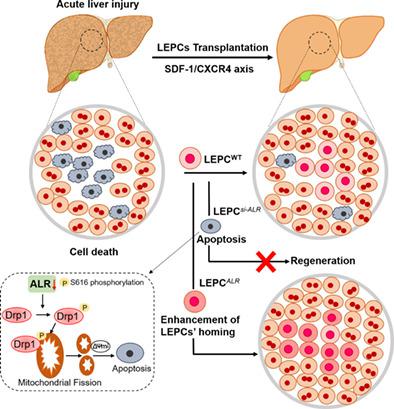当前位置:
X-MOL 学术
›
STEM CELLS
›
论文详情
Our official English website, www.x-mol.net, welcomes your
feedback! (Note: you will need to create a separate account there.)
Downregulation of augmenter of liver regeneration impairs the therapeutic efficacy of liver epithelial progenitor cells against acute liver injury by enhancing mitochondrial fission
STEM CELLS ( IF 4.0 ) Pub Date : 2021-07-26 , DOI: 10.1002/stem.3439 Yuan Dong 1 , Weining Kong 1 , Wei An 1
STEM CELLS ( IF 4.0 ) Pub Date : 2021-07-26 , DOI: 10.1002/stem.3439 Yuan Dong 1 , Weining Kong 1 , Wei An 1
Affiliation

|
Cell-based therapeutic approaches have been proven to be effective strategies for the treatment of acute liver injury (ALI). However, widespread application of these procedures is limited by several key issues, including rapid loss of stemness in vitro, aberrant differentiation into undesirable cell types, and low engraftment in vivo. In this study, liver epithelial progenitor cells (LEPCs) were characterized and transfected with augmenter of liver regeneration (ALR). The results revealed that in ALI mice with CCl4, the transplantation of ALR-bearing LEPCs into the liver markedly protected mice against ALI by decreasing the levels of alanine aminotransferase (ALT) and aspartate aminotransferase (AST), thus relieving hepatic tissue injury and attenuating inflammatory infiltration. Mechanistically, the knockdown of ALR in LEPCs activated the phosphorylation of dynamin-related protein 1 (Drp1) at the S616 site and thereby enhanced mitochondrial fission. In contrast, the transfection of ALR into LEPCs significantly inhibited Drp1 phosphorylation, thereby favoring the maintenance of mitochondrial integrity and the preservation of adenosine triphosphate contents in LEPCs. Consequently, the ALR-bearing LEPCs transplanted into ALI mice exhibited substantially greater homing ability to the injured liver via the SDF-1/CXCR4 axis than that of LEPCs-lacking ALR. In conclusion, we demonstrated that the transplantation of ALR-transfected LEPCs protected mice against CCl4-induced ALI, thus offering immense curative potential in the clinic.
中文翻译:

肝再生促进剂的下调通过增强线粒体裂变损害肝上皮祖细胞对急性肝损伤的治疗效果
基于细胞的治疗方法已被证明是治疗急性肝损伤 (ALI) 的有效策略。然而,这些程序的广泛应用受到几个关键问题的限制,包括体外干性的快速丧失、异常分化成不良细胞类型以及体内低植入。在这项研究中,肝上皮祖细胞 (LEPC) 被表征并用肝再生增强剂 (ALR) 转染。结果表明,在具有CCl 4的ALI小鼠中, ALR的移植- 将 LEPC 带入肝脏,通过降低丙氨酸氨基转移酶 (ALT) 和天冬氨酸氨基转移酶 (AST) 的水平,显着保护小鼠免受 ALI,从而减轻肝组织损伤并减轻炎症浸润。从机制上讲,LEPC 中ALR的敲低激活了 S616 位点的动力相关蛋白 1 (Drp1) 的磷酸化,从而增强了线粒体裂变。相比之下,ALR转染LEPCs 显着抑制 Drp1 磷酸化,从而有利于维持线粒体完整性和 LEPCs 中三磷酸腺苷含量的保存。因此,ALR与缺乏ALR的 LEPC 相比,移植到 ALI 小鼠中的携带 LEPC 通过 SDF-1/CXCR4 轴对受损肝脏的归巢能力显着增强。总之,我们证明了ALR转染的 LEPC 的移植保护小鼠免受 CCl 4诱导的 ALI,从而在临床上提供了巨大的治疗潜力。
更新日期:2021-07-26
中文翻译:

肝再生促进剂的下调通过增强线粒体裂变损害肝上皮祖细胞对急性肝损伤的治疗效果
基于细胞的治疗方法已被证明是治疗急性肝损伤 (ALI) 的有效策略。然而,这些程序的广泛应用受到几个关键问题的限制,包括体外干性的快速丧失、异常分化成不良细胞类型以及体内低植入。在这项研究中,肝上皮祖细胞 (LEPC) 被表征并用肝再生增强剂 (ALR) 转染。结果表明,在具有CCl 4的ALI小鼠中, ALR的移植- 将 LEPC 带入肝脏,通过降低丙氨酸氨基转移酶 (ALT) 和天冬氨酸氨基转移酶 (AST) 的水平,显着保护小鼠免受 ALI,从而减轻肝组织损伤并减轻炎症浸润。从机制上讲,LEPC 中ALR的敲低激活了 S616 位点的动力相关蛋白 1 (Drp1) 的磷酸化,从而增强了线粒体裂变。相比之下,ALR转染LEPCs 显着抑制 Drp1 磷酸化,从而有利于维持线粒体完整性和 LEPCs 中三磷酸腺苷含量的保存。因此,ALR与缺乏ALR的 LEPC 相比,移植到 ALI 小鼠中的携带 LEPC 通过 SDF-1/CXCR4 轴对受损肝脏的归巢能力显着增强。总之,我们证明了ALR转染的 LEPC 的移植保护小鼠免受 CCl 4诱导的 ALI,从而在临床上提供了巨大的治疗潜力。











































 京公网安备 11010802027423号
京公网安备 11010802027423号